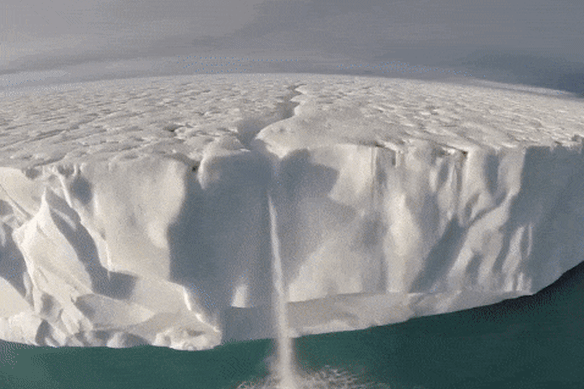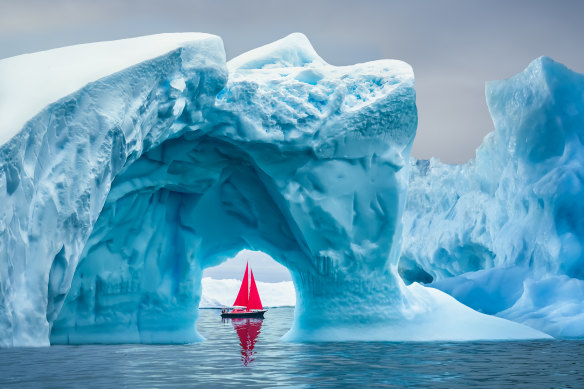This was published 1 year ago
The shrinking ice sheet raising sea levels and disrupting ocean cycles

The Greenland ice sheet, an expanse of frozen water larger than two NSWs or seven Victorias, is disappearing much faster than scientists believed.
New data suggests the extent of ice sheet loss since 1985 has been underestimated by as much as 20 per cent, scientists wrote in a new paper published in Nature.
More freshwater ice in the Atlantic could affect ocean circulation, disrupt fish ecosystems and accelerate the melting process, contributing to rising sea levels.
How the ice loss was missed
The paper, Ubiquitous acceleration in Greenland Ice Sheet calving from 1985 to 2022, describes how scientists have failed to consider the full impact of ice calving – when large chunks of ice break off from the edge of a glacier.
“The surprise was just the ubiquity of the signal,” said lead author Chad Greene, a glaciologist with NASA’s Jet Propulsion Laboratory in Pasadena, California. With the exception of “one minuscule little glacier” that grew modestly, Greene said, “there’s just been retreat everywhere we’ve looked. It’s on every corner of the island.”
NASA satellites tracked a rapid decline in the mass of the ice sheet between 2001 and 2021, when it shed 280 billion tonnes of ice a year on average. That marked a significant acceleration compared with the preceding decades and is equivalent to 767 million tonnes of ice lost every day.
The above animation, which is based on data from NASA satellites, appears darker where ice mass was lost between 2002 and 2022. The barely perceptible blue patches represent growth in ice mass, while white means little to no change.
Most of the loss was along Greenland’s west coast, while central high-altitude areas were relatively unchanged. Lower elevation and coastal areas lost five metres worth of water over the 19-year period.
Impact on rising sea levels
Much of the newly discovered lost ice shelf was already underwater, so while the additional mass identified by the team will have affected ocean circulation and temperatures, it will not have contributed to rising sea levels directly.
However, this loss means more of Greenland’s mainland will be exposed to warming waters which, in turn, lead to melting and rising seas.
“What we’re seeing is that the clog in this bottleneck has been removed, and as a result, the glaciers all around Greenland have been able to speed up the melting process,” Greene said. “You take the ice out of the fjord and glaciers speed up and start contributing to sea level rise.”
Disrupting ocean cycles
Large blocks of freshwater ice floating away into the ocean are problematic as they could disrupt the Atlantic Meridian Overturning Circulation, a crucial ocean circulation pattern.

Ice cannot hold salt, so when seawater freezes in the Arctic, the salt sinks to the bottom making the water denser. The denser water then moves south with cold currents, and the warm water rises to the surface and flows north in response. This cycle warms Europe and distributes crucial nutrients for ocean life.
It is not known how the large chunks of ice floating off into the sea will affect this cycle, but they have not been included in climate models. In the long term, it will depend on where the billions of tonnes of freshwater end up – and that is not easy to predict.
Scientists shocked by discovery
Julienne Stroeve, the chief science officer at Arctic Basecamp, a non-profit group of Arctic experts, and a professor of polar observation and modelling at University College London, said 1000 billion tonnes more ice in the ocean was a larger discrepancy than modellers could have imagined.
The long-term impacts may not be clear, but there were already measurable differences in the surrounding areas, Stroeve said.
“The only region of the planet that’s kind of cooling is actually off the south-eastern coast of Greenland, in the ocean, and that could be due to freshening of the ocean from more meltwater from Greenland.”
with Bloomberg